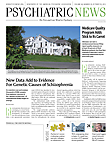Alice: Would you tell me, please, which way I ought to go from here?The Cat: That depends a good deal on where you want to get to.
—Lewis CarrollAlice’s Adventures in Wonderland
The first two articles in this series addressed the prospect of change in psychiatric medicine and mental health care and the anticipated effects, in this regard, of health care reform. In this article we discuss the current status of biomedical research and how it will impact our field and practice.
The research enterprise has brought clinical psychiatry to an exciting but treacherous juncture. Based on remarkable new tools and technologies in genetics and neuroscience, there has been an explosion of new knowledge about the etiology and neural underpinnings of schizophrenia, bipolar disorder, Alzheimer’s disease, autism, addictions, and other serious conditions. Indeed, the fields of psychiatric medicine and mental health care are poised on the brink of transformative advances in diagnostic methods and therapeutic modalities. However, just at the time when biomedical research is gaining significant traction and momentum in understanding the brain and mental disorders, support for all research, and most importantly biomedical research funded by the National Institutes of Health, is painfully contracting, the result of congressionally driven budget cuts. Just as scientific opportunity in our field is waxing, the ability to exploit it is waning.
The recent budget sequestration has had a huge negative effect, but is part of a larger pattern of what has been eroding the support for research in the United States. The decline in research funding affects all of medicine, but psychiatry faces a special problem. Since 2010, the pharmaceutical industry has substantially retreated from research on psychiatric disorders despite years of commercial success with antidepressants and antipsychotic drugs. Payers, and in Europe regulators, are resisting the longstanding pattern of industry marketing new psychiatric drugs that often have milder side-effect profiles but lack significant improvements in efficacy over existing treatments. Leaders in industry recognize the promise of new discoveries being made in psychiatry. However, they see this emerging work as too early to apply to the development of truly novel treatments, including much-needed treatments for conditions such as the cognitive and negative symptoms of schizophrenia and the core social and communication disabilities of autism that currently lack effective pharmacologic interventions. The retreat of industry further decreases funds for psychiatric research and discourages young scientists from entering the field.
Consequently, it is critical for psychiatrists, neuroscience researchers, and patient advocacy groups to make a case for funding by the government and foundations and to help convince industry to resume psychiatric research, albeit on a new and better scientific footing.
Some of the most exciting scientific research on the brain and mental disorders has been in the areas of genetics and stem-cell technology.
Genetics
Why is it important to discover specific genes that are involved in the etiology of psychiatric disorders? It is because genes encode the information to produce the ribonucleic acid (RNA) molecules and proteins that are the key building blocks of our cells. When a particular variation in the sequence of a person’s DNA increases risk for an illness, it is a clue to the cellular process that has gone awry and that might ultimately lead to a therapy. Discovery of genes that produce risk of psychiatric illness allows us to follow the successful lead of other fields of medicine such as oncology. Cancer therapeutics has a long way to go, but there is great excitement in the field; indeed, many companies that have deemphasized psychiatry are highly focused on cancer. This is because a large number of the genetic mutations have been discovered within cancer cells, and some have been shown to play causal roles, for example, by dysregulating cell division. Many new cancer therapies target the biological effects of specific gene mutations in cancer cells. These therapies fail when new mutations occur in cancer cells that make them resistant to the treatment (like bacterial infections in which the organisms develop resistance to antibiotics); eventually, cancer may be treated with combination treatments that make it difficult for the cells to escape—like current treatments for HIV.
Although the path from genes to treatments is being blazed by other fields, psychiatry has a harder problem. The causative de novo mutations in cancer cells are thought to occur as a result of errors in repairing DNA after exposure to environmental toxins such as cigarette smoke. The mutations then exert their disease burden by amplification during active cell division. Since psychiatric diseases are thought to reflect dysfunction of ensembles of nondividing neurons, somatic mutations targeting an individual cell are much less likely to produce a psychiatric disease phenotype the way they would in cancer. The DNA changes associated with mental disorders are those we are born with and are thus in every cell in the body. In addition, they tend not to be harmful mutations that can act alone, but variations that create risk only when they come together in infelicitous combinations. Finally, psychiatric symptoms do not result from the action of rogue cells that can be retrieved by a surgeon and made available for science. Instead they result from patterns of communication in highly distributed neural circuits within our brains. What is exciting is that we can now discover DNA sequence variation in the human genome that creates risk for psychiatric disorders. We can also turn human skin cells into neurons in the lab using recent stem-cell technologies and use these neurons to compare versions of particular genes that do or do not increase risk of psychiatric disorders. Finally there are new tools to study the function of cells and circuits in the brain.
The scientific challenge for psychiatry is that genetic risk for disorders such as schizophrenia or bipolar disorder does not result from one or two damaging mutations, but rather from the interaction of many—perhaps hundreds—of genes containing sequence variants of modest effect. How would it be possible to detect many small increments of risk against the background of normal human genetic variation? The answer has been the genomic revolution. The cost of determining DNA sequences has declined by a factor of 1 million over the last decade. It is thus possible to examine enormous numbers of people with particular psychiatric disorders. The result is that as recently as 2007, there were no genes known with certainty to increase risk of schizophrenia. Today there are more than 100 regions in the genome of which we have confident associations with schizophrenia, and the pace of genetics research is accelerating. What will it ultimately mean for psychiatric practice? Often it is thought that genetics will provide important tools to improve diagnosis. This will eventually be true, but given the large number of relevant genes that remain to be identified and the fact that some risk genes are shared across disorders, the utility for diagnostics will initially be very limited. The real excitement is that these findings provide clues to what goes wrong in the brain to produce illness. As we build up a picture of the incremental risks for illness in the form of genetic variants, we will be in a far better position to design treatments.
Stem-Cell Technologies
The human brain is protected by the hard and opaque bones of the skull, and for both ethical and pragmatic reasons, biopsies are rare. Moreover, even when obtained, a biopsy of an adult brain is highly resistant to the tissue culture process. More accessible tissues like blood and skin do not necessarily provide information about disturbances in the brain. Animal models of human disease can be useful, but the human forebrain, and especially the human prefrontal cortex, have features that are new in evolution. How then can we learn what disease risk genes are doing in the cells that make up the human brain? This daunting problem is getting an answer from stem-cell technologies. In 2012 a Japanese physician scientist won the Nobel Prize for developing a simple method to transform skin cells (dermal fibroblasts) that can be readily obtained from a punch biopsy into pluripotent cells that can become any cell type in the body. These induced pluripotent cells (iPS cells) can be readily differentiated into neurons. Today many scientists are learning how to turn iPS cells or even skin fibroblasts into different types of neurons including those thought to be affected in schizophrenia, bipolar disorder, and autism. Others are collecting skin cells from patients whose genomes have been studied and turning them into neurons for study. Yet others are attempting to turn engineered neurons into small neural circuits to study their patterns of communication with and without disease risk mutations. Circuits might be assembled on a “chip” using small wells etched into an appropriate support or might be assembled in three-dimensional gels. Such technologies are so new that they are not ready for routine application to drug discovery. They are potentially so powerful, however, that a few companies that had abandoned psychiatry are starting up small exploratory programs.
Psychiatry is fortunate that reprogrammed stem-cell technologies have emerged only a few years after the application of modern genomics has begun to yield genes associated with mental illness. This second enormous technological step has permitted investigations to turn emerging genetic information into biological experiments with implications for therapeutics.
One aspirational view of how a therapeutic discovery program in psychiatry might look in the near future follows. Enough risk-associated genetic variation will be known for some disorders in five years to put much of the genetic jigsaw puzzle of risk together. (Already in schizophrenia, many proteins have been implicated by genetics that act in the specialized postsynaptic structures of neurons that receive excitatory signals from the neurotransmitter glutamate.) Studies of relevant protein networks in neurons will help identify a subset that could usefully be targeted by drugs; characterizing the genes that encode those proteins would become a priority. Human cells encoding selected genes—both risky and healthy versions—would be engineered into iPS cells. These, in turn, would be differentiated into relevant neurons and perhaps assembled into small circuits. The biochemistry and physiology of cells with risky and healthy versions of the genes could be compared, and then drug screens could be developed that would identify compounds that normalized disease-risk-associated changes. Such drugs would still be studied in animals for toxicity and assessment of behavioral effects. The main difference from our current approach to drug development is that instead of having to guess about which proteins to target with drugs (or as is now the case, sticking with existing targets and hoping for better results), we could allow the genes that are in the causal chain of pathogenesis to point the way. There are no guarantees, and certainly not enough funding for this research, but it truly appears to be a new way and a new day. ■

